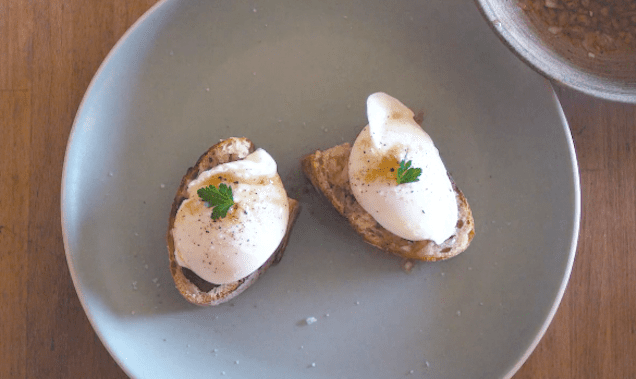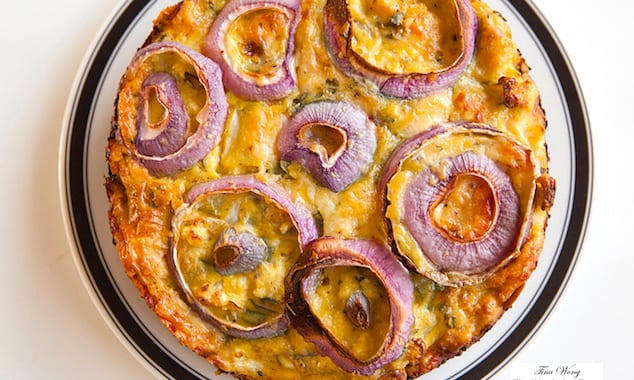This is a weekend brunch favorite in the Lowe + Helzer household and it has guided my education in the art of the poach. At long last, revealed below is my technique for the perfect poach. The recipe is adapted from Alice Waters’ In The Green Kitchen. The primary difference is that in her version the vinaigrette involves macerated tomatoes and halved garlic cloves which are removed before serving. I do that sometimes when tomatoes are in season. But on a normal basis, even if my kitchen is low on everything, I’ve got the makings for this brunch poach. And it’s super tasty. Print
Poached Egg Bruschetta w Shallot Vinaigrette
Description
At long last, revealed here is my technique for the perfect poach as well as the Lowe + Helzer go-to vinaigrette that we literally make every night. I love it! Hope you do too.
Ingredients
- Vinaigrette Ingredients:
- 1/4 – 1/2 minced shallot
- 2 tbs. olive oil
- 1 tbs. red wine vinegar
- 1 tbs. sherry vinegar
- 1 tsp. nutritional yeast
- salt and pepper to taste
- Poach Ingredients:
- Eggs
- dash of vinegar
- dash of salt
Instructions
- Vinaigrette Method – Mix together all ingredients!
- Poach Method – Boil enough water to cover an egg, shell and all, say 2-3 inches.
- Add a dash of salt to the water as well as a dash of vinegar. Red wine or sherry vinegars work great. I use the less expensive stuff for this.
- Now take a small strainer, like a tea strainer and crack your egg into it. You’ll notice the sack and then there’s some extra bits of the white, those will drip through, giving you fewer flyaways in your poach. Let it strain for minute but don’t let it sit for too long, otherwise, it’ll get a bit stuck.
- You want your water to be just below boiling, where it’s sort of got a wave of heat movement but it’s not bubbling.
- Drop your egg into the water. It’ll just drop to the bottom and sit.
- Once it’s got a bit of white to it, I usually give it a little nudge so it doesn’t stick to the bottom. A gentle tornado around the egg works here so that you don’t break the white sack or the yolk. It’s fragile!
- Use a slotted spoon to check it every so often. You can tell if the white looks like it’s too runny inside. You want the white to be soft but not liquid-y. And the yolk to be super soft. Give it a soft touch and you’ll know when it’s done.
- Finally – Toast up some good bread – a nice baguette or a slice of a wonderful country loaf. (Locally, we are big fans of Brickmaiden, made in Pt. Reyes.)
- Pour a few spoons of vinaigrette over the bread
- Place your poached eggs atop
- Season with a sprinkle of Fleur de Sel and Pepper, another splash of vinaigrette if you’d like
- Garnish with a sprig of greens or parsley
- It’s really nice served with a small green salad too. Enjoy!
- Category: Brunch
Poach Method:
I’m not sure there is one magic bullet technique, but here’s what I’ve found works for me – fresh fresh fresh eggs are best. We have the pleasure of purchasing our eggs most often from the local farm, Gospel Flat, so they are crazy fresh. Another important variable, regardless of freshness, is temperature. Because the temperature tends to be cool here in Bolinas, and because we spent time in France and were enchanted by the way folks do it there, we leave our eggs out of the fridge, so they are always at room temp. If you keep them in the fridge, it’ll help to take them out an hour before you’re going to poach. I’ve experimented with the tornado technique – the theory being that it helps the egg hold together – but I find that truly fresh eggs hold together naturally, so there’s no real need for the spin cycle.
Boil enough water to cover an egg, shell and all, say 2-3 inches.
Add a dash of salt to the water as well as a dash of vinegar. Red wine or sherry vinegars work great. I use the less expensive stuff for this.
Now take a small strainer, like a tea strainer and crack your egg into it. You’ll notice the sack and then there’s some extra bits of the white, those will drip through, giving you fewer flyaways in your poach. Let it strain for minute but don’t let it sit for too long, otherwise, it’ll get a bit stuck.
You want your water to be just below boiling, where it’s sort of got a wave of heat movement but it’s not bubbling.
Drop your egg into the water. It’ll just drop to the bottom and sit.
Once it’s got a bit of white to it, I usually give it a little nudge so it doesn’t stick to the bottom. A gentle tornado around the egg works here so that you don’t break the white sack or the yolk. It’s fragile!
Use a slotted spoon to check it every so often. You can tell if the white looks like it’s too runny inside. You want the white to be soft but not liquid-y. And the yolk to be super soft. Give it a soft touch and you’ll know when it’s done.
Poached Egg Bruschetta w Shallot Vinaigrette:
Toast up some good bread – a nice baguette or a slice of a wonderful country loaf. (Locally, we are big fans of Brickmaiden, made in Pt. Reyes.)
Pour a few spoons of vinaigrette over the bread
Place your poached eggs atop
Season with a sprinkle of Fleur de Sel and Pepper, another splash of vinaigrette if you’d like
Garnish with a sprig of greens or parsley
It’s really nice served with a small green salad too. Enjoy!





















